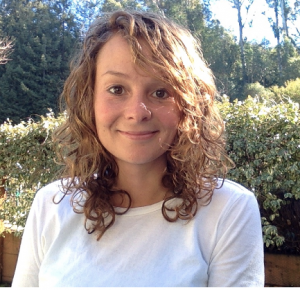 Ellie Cross is interested in using art as a problem-solving tool to create a more just world.
Ellie Cross is interested in using art as a problem-solving tool to create a more just world.
A native of Seattle, WA, Ellie has painted murals designed to raise environmental consciousness in Malaysia, Thailand, Guatemala and the U.S. Her research in art activism and education has taken her to Ghana and Tibetan exile communities in Nepal, India and Tibet. Her work in the visual arts has included teaching children in Cambodia, Nicaragua and El Salvador.
She earned a B.A. in Studio Art from Scripps College in Claremont, CA (2007) and studied water color, pastel, ceramics, perspective drawing and woodblock printmaking at Gage Academy in Seattle (2010-11). During her three years in in Mumbai, India (2011-2014), she learned about folk art and enameling techniques from local artists. “In my daily work of making art with kids,” she said, “I continue to learn about the power of imagination, the durability of creativity and the tactile joy of the process.”
A few of Ellie’s illustrations will appear in our relaunch issue of Emergence, which will be published in June. View Ellie’s portfolio at www.artworkworks.com.
How did you first hear about Metta Center for Nonviolence?
A few months ago, a dear friend set me a link to the website and the work really resonated with me.
What first inspired you to see art as a tool for change?
My original appreciation for the power of art as a tool for social change is founded on the research I conducted with Tibetan exile communities while studying abroad in Nepal, India and Tibet.
I actually began my research studying how the Tibetan culture was being commodified by the West for consumption. My cynicism was inconsistent with the interviews I conducted, however, and I found instead that refugees were using art to creatively solve a myriad of problems they faced while living in exile.
 This work provided a solid foundation as I continued my research and facilitated community-based art projects in Ghana the following semester. Under the mentorship of a local artist and educator, I began by interviewing locals about pressing environmental issues in the area. We concurrently paired with a neighborhood school to provide art instruction to a group of underserved adolescents. Based on interview results and the kids’ ideas, the students designed meaningful environmental messages to paint on a new public dumpster. We ended the day and solidified our understanding with a beach cleanup. The art workshops culminated in a mural we painted at the kids’ school with a message of responsibility and empowerment: “We create our future.”
This work provided a solid foundation as I continued my research and facilitated community-based art projects in Ghana the following semester. Under the mentorship of a local artist and educator, I began by interviewing locals about pressing environmental issues in the area. We concurrently paired with a neighborhood school to provide art instruction to a group of underserved adolescents. Based on interview results and the kids’ ideas, the students designed meaningful environmental messages to paint on a new public dumpster. We ended the day and solidified our understanding with a beach cleanup. The art workshops culminated in a mural we painted at the kids’ school with a message of responsibility and empowerment: “We create our future.”
How did you come to realize that art is your key contribution?
I had an amazing arts teacher in kindergarten who nurtured my creativity and empowered me to see myself as an artist. As I grew up and became aware of the many systems of violence and oppression operating in our world, I felt an increasing need to find ways to work with others to address and dismantle what bell hooks calls the “white supremacist capitalist patriarchy.”
My artistic practice is greatly influenced by an effort to reconcile these two factors: finding ways to integrate my innate passion for visual art with a desire to work for social and environmental justice for all.
Where do the power of art and the power of nonviolence meet for you?
I am a firm believer that creativity is a powerful counterforce to destruction, and that part of the strength of art as a tool is that it works in mysterious ways to promote inner peace for individuals while bringing communities together in a manner that transcends the traditional limitations we face when trying to dismantle oppressive systems.
Can you offer us any insights about the roles art can play in activism and education, particularly among communities living in deep poverty?
As a white American traveling abroad, I am wary of the tendency for my volunteer work to become paternalistic. Art feels like a ideal tool for activism and education because it’s simply my personal path of following my bliss and sharing that with others around me. Without needing to force anything or push an agenda of “helping” others, I find that community art projects are effortlessly influential in subtle ways. The simple act of painting with the children of sex workers on their shelter walls creates an atmosphere of joy that speaks for itself. The kids are empowered by having volunteers assist them in their work. The fact that the space is brightened by the art is just a bonus. Part of the power of the work is that I don’t fully understand it, but I can feel it working.
If you were to summarize your art into a central message, what would it be—and to whom would it speak?
Art, be it performance or visual, is a dynamic tool which can be tapped to address a wide variety of issues facing our world today. I hope it would speak to everyone, but we all hear messages when and how we need to, so I suppose it’s for whomever it resonates with at this moment.











